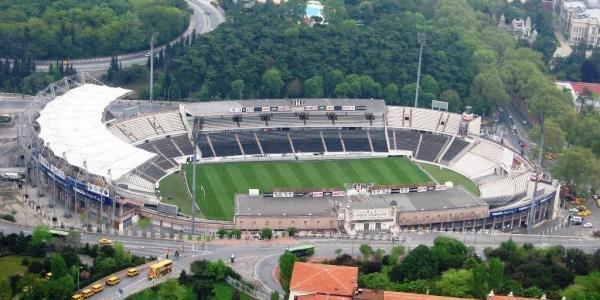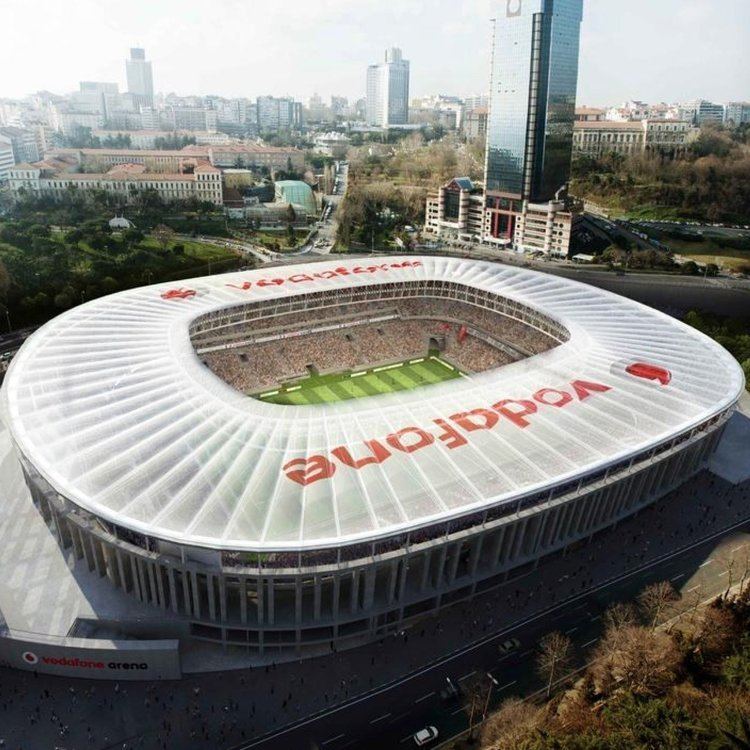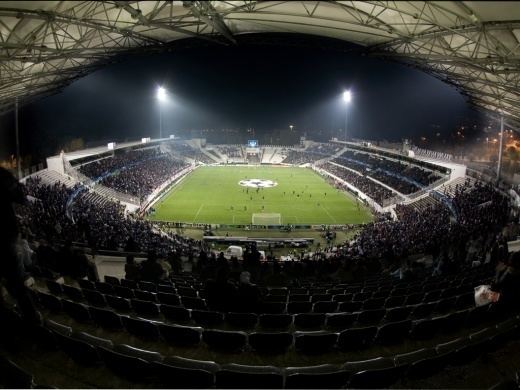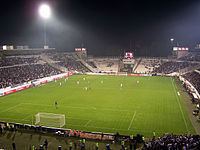Location Beşiktaş, İstanbul Surface Grass Capacity 32,145 Owner Beşiktaş J.K. Architect Bünyamin Derman | Field size 105 x 68 m Broke ground 1939 Opened 19 May 1947 Executive suites 47 | |
 | ||
Full name Beşiktaş İsmet İnönü Stadium Former names Dolmabahçe Stadium (1947-1952)Mithatpaşa Stadium (1952-1973)İnönü Stadium (1973-2013) Similar Vodafone Arena, Türk Telekom Arena, Şükrü Saracoğlu Stadium, Atatürk Olympic Stadium, Dolmabahçe Palace | ||
İnönü Stadium (Turkish: İnönü Stadyumu) was a football stadium in Istanbul, Turkey and the home ground of the football club Beşiktaş J.K.. Previously the ground had also been shared with Galatasaray and Fenerbahçe S.K.. The ground was located in Dolmabahçe, close to the Dolmabahçe Palace in the district of Beşiktaş, on the European side of Istanbul. The stadium was demolished except the walls of the Eski Açık tribune and its historical towers to rebuild a new stadium at the same location which is called Vodafone Arena.
Contents
The all-seater stadium had the capacity to host 32,145 spectators.
Structure

BJK İnönü Stadium had three stands: The Kapalı tribune which was parallel to the pitch at the north side can hold up to 5,881 supporters and it was regarded as the heart of the stadium, traditionally holding the most fanatical supporters. Facing the Kapalı was the Numaralı with a seating capacity of 5,237. The stands behind the goal areas were Eski Açık with a seating capacity of 7,962, and Yeni Açık with a seating capacity of 13,065. There were two towers on the left and right side of the Eski Açık stands. Before the stadium became all-seater, the ground's capacity was over 39,000.

The Bosphorus, Dolmabahçe Palace, Dolmabahçe Clock Tower, Dolmabahçe Mosque, and Maiden's Tower are all viewable from the top rows of the Yeni Açık stand of the stadium, which makes it the only stadium in the world from which a football fan can view two continents, Europe and Asia, which are separated by the Bosphorus strait.
History

BJK İnönü Stadium (originally named the Dolmabahçe Stadium) was designed by Italian architect Paolo Vietti-Violi, who collaborated with Turkish architects Şinasi Şahingiray and Fazıl Aysu for preparing the project. The stable of the Dolmabahçe Palace was chosen as the location to build the stadium. The first foundation was laid on May 19, 1939, but the construction works were frozen due to the outbreak of the Second World War. The stadium was inaugurated on May 19, 1947, by İsmet İnönü, the second President of Turkey and himself a Beşiktaş fan, and Lütfi Kırdar, the Governor of Istanbul. The initial capacity was 16,000. In the original project plan, there were two bronze statues of athlete figures at the Eski Açık tribune: One throwing a discus, and the other one throwing a javelin. However, the statues were never built due to financial concerns. The oil factory which was found behind the stadium was demolished to construct the Yeni Açık tribune at the west part of the stadium in 1950 (hence the name Yeni Açık, meaning the New Uncovered tribune; referring to the two covered tribunes (Numaralı and Kapalı) and the two uncovered tribunes (Eski Açık and Yeni Açık). Yeni Açık was also covered with a separate roof structure in 2004. Galatasaray and Fenerbahce S.K. have shared the stadium with Beşiktaş JK for many years, since the construction of the Ali Sami Yen Stadium, which is the home of Galatasaray football club, was completed in 1964. Şükrü Saracoğlu Stadium, the home of Fenerbahçe S.K., was renovated in 1982.

The first football match at the Dolmabahçe Stadium took place between Beşiktaş JK and AIK Stockholm of Sweden, on November 27, 1947, and the first goal in the stadium was scored by Süleyman Seba; the most famous and longest-presiding Chairman of the club (in the 1980s and 1990s) when he used to be a player of Beşiktaş JK. Beşiktaş won this match 3–2. In 1952, the stadium was renamed as the Mithat Paşa Stadium, and later in 1973, it was renamed as the İnönü Stadium. A leasing contract was signed between Beşiktaş JK and the Ministry of Youth and Sports in February 1998 which gave all usage rights of the İnönü Stadium to Beşiktaş JK for 49 years.

Renovation work took place at the BJK İnönü Stadium in 2004. The tartan track was removed within the scope of these activities and the ground level was lowered by 4 meters to increase the capacity of the stadium to 32,145 spectators. The press seats were relocated to the Numaralı tribune from the Kapalı tribune. The lounges that were found in the middle of the Kapalı tribune were demolished and for the first time in Turkey, the wire fence between the tribunes and the pitch were removed for space. The number of the gates were increased by 100%. A press center for Beşiktaş TV was built inside the stadium. The toilets and the launch counters were renewed. The Yeni Açık tribune was covered with a metallic structure. It complies with the UEFA standards.
Music
New Inönü Stadium project

Due to the unique location of the stadium and its legal status as a "historic monument" protected by the High Council of Monuments of Turkey, the renewal project had to be modified and postponed several times and all official requests, efforts, renewal attempts were denied until 2013. The administrative procedures were eventually completed, and all required permission was given to the club. Club president Fikret Orman announced that the new stadium, with a total capacity of 41,903 spectators, 143 luxury lodges, and one "1903 lodge", will be constructed. The "1903 lodge" will have a capacity of 636 spectators. The new stadium will also have 2,123 square meters of restaurants, 2,520 square meters of terrace restaurants and a VIP parking of 600 vehicles. The demolition works started by 2 June 2013, following the end of the promotion play-offs of the TFF First League. Construction works are scheduled to be completed at April 2015, and the estimated cost of the project is around $80 million.
The project of the new stadium was designed by DB architects. The old stadium will be demolished, except for the Eski Açık tribune, since this tribune and its towers are historical monuments. The Eski Açık tribune will be re-arranged like an antique amphitheater. The new stadium will be in harmony with the natural and historic landscape of the Bosphorus when seen from the sea.
